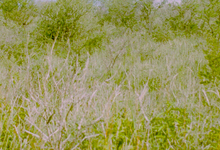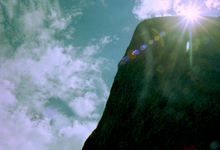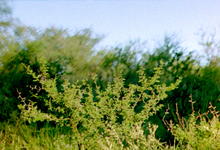- Images (3)
- Liens (1)
- Agenda

|

|

|
Ceniza verde (2019) by Pablo Mazzolo is part of the Atelier 105 film program that you can watch here from Monday 22 to Sunday 28 February 2021.
This interview is published in English and Spanish.
The Henia Kamiare culture was practically annihilated, and only a few vestiges of its existence remain, to such a point that their culture and their history are almost impossible to reconstruct today. This culture, which is impossible to film and necessitates an almost ghostly research is something I have always found exciting.
I started by filming what the Spaniards called “Salamancas”, which were sacred places where the Henia Kamiare shared their knowledge. Generally, these places were in locations that are very difficult to access, so that the Spaniards couldn’t find them, and they can only be reached with help from local indigenous people. I wasn’t concerned about showing what every particular space symbolized. What mattered to me was the symbolic relation between the sacred places and the present.
The Henia Kamiare inhabited the Córdoba Sierras since 500 A.D. and were never dominated by the Incas nor the Spaniards. The mythical narrative relates that there was a mass suicide from what is now known as the Ongamira mountain. Of course, I’m speaking as a filmmaker who has done research, not as an historian or an anthropologist.
I was interested in the collective suicide, not as an heroic myth of the end of this culture, but as a fact. I wondered if it had really happened and how.
I was advised by anthropologists from the Maccat Henen museum and the UNC Anthropology Museum. Two very different places. The first is a local museum in a small mountain town, La Higuera. The second is connected to the National University of Córdoba.
There is a chronicle from the Spanish crown where it is written that in 1575, in an act of rebellion by the Henia Kamiare, mayor Blas Rosales is killed. After this incident, the governor, Suárez de Figueroa, decides to lash out at the Comechingones [collective term for the indigenous people of the Córdoba and San Luis provinces] once and for all. What we know of the rest of this story comes from oral tradition. The Henia Kamiare had entrenched themselves in the Charalqueta mountain, which was a sacred mountain whose name referred to the god of joy and happiness. That place was of difficult access to the Spaniards, and the Henia Kamiare were able to keep them away for a few days. According to accounts, the Spaniards finally cornered them, and about 1,800 Henia Kamiare were slaughtered. The men died fighting. But the elderly and the women with their children plunged to their deaths so as to not yield to the conquerors. Surely, cornered against the precipice, many were forced to commit suicide as they had no other choice. The Charalqueta mountain, which honored the god of joy and happiness, came to be called Colchiqui for the god of sadness and misfortune.
In Ceniza verde, the myth has organized and sacralized the space as a large graveyard. Fact gave me the documentary basis I needed: the myth’s relation to the territory, the space and the present.
What about your camera techniques and the hand-drawn maps you have inserted in the edit?
Maps are a concrete, spatial reference. It is like going outside to breathe and see where we are after the encounter with the myth. Positioning ourselves in real coordinates. There is something resembling an epilogue, where certain information that was absent from the film is given. What’s important is to reference the location as a territory, rather than as part of the state of Argentina. That is why the raised hand is more interesting conceptually, given that there wasn’t yet the idea of Argentina as it is today. The definition of territory is also experienced as a myth. Something that floats throughout the film. Boundaries in constant fluctuation. Something that can in some way be redrawn.
I worked with many techniques, but all of them were optical. I am interested in creating a code that will allow for different techniques. A fluctuating image. I wasn’t looking for just one kind of image throughout the entire film. I used different film stocks. The effects on rocks and plants with different focus and movement were made by manipulating the lens by hand, sometimes doing variations of focus, sometimes rewinding and superimposing. The colors with fluorescent flashes were superimpositions of positive material over negative using an optical printer. And at the end, everything was color-graded by Yannis Davidas at Light Cone.
What are the challenges you face as an experimental filmmaker in Argentina today?
As filmmakers, the challenge is to make the film we want to do. With no concessions or excuses. Without complaining.
La cultura Henia Kamiare fue prácticamente aniquilada, y solo quedan muy pocos vestigios de su existencia. Al punto casi imposible de reconstruír hoy su cultura y su historia. Esa cultura imposible de filmar es algo es casi una búsqueda fantasmagórica que siempre me resultó excitante.
Comencé filmando lo que los Españoles llamaban “Salamancas”, que eran lugares sagrados, donde los Henia Kamiare compartían su conocimiento. En general son lugares de muy difícil acceso, para que los españoles no los encontraran y solo se puede acceder mediante referencias de nativos locales. No me preocupé porque se sepa qué simbolizaba cada espacio en particular. Lo que importaba era la relación simbólica entre lugar sagrado y el presente.
Los Henia Kamiare habitaban las Sierras de Córdoba desde el 500dc y nunca fueron dominados ni por los Incas, ni por los españoles. El relato mítico, cuenta que hubo un suicidio masivo desde el actual cerro Ongamira. Hablo como cineasta que investigó, y no como historiador o antropólogo, está claro.
Me interesaba el suicidio colectivo, no solo como mito heroico del fin de esta cultura, sino como hecho fáctico. Me preguntaba si realmente había sucedido y cómo.
Trabajé asesorado por antropólogos del Museo Maccatt Henen y del Museo de Antropologia de la UNC. Dos lugares muy distintos. El primero es un museo local en pequeño pueblo en la sierra, la Higuera. El segundo depende de la Universidad Nacional de Córdoba.
Existe un registro de la corona española, donde está escrito que en 1575, en un acto de rebelión por parte de los Henia Kamiare, resulta muerto el alcalde Blas Rosales. A partir de este incidente, el gobernador-Suarez de Figueroa- decide arremeter definitivamente contra los comechingones. Lo que luego conocemos de la historia, proviene de la tradicion oral. Los Henia Kamiare se habían fortificado en el cerro Charalqueta, que era un cerro sagrado cuyo nombre refería al dios de la alegría y felicidad. Era un lugar de difícil acceso para los Españoles y los nativos pudieron disuadirlos unos días. Pero los españoles realizaron un rodeo con sus caballos y al llegar los exterminaron. Según los relatos, cerca de 1.800 nativos fueron asesinados por los españoles. Los hombres murieron luchando. Pero los ancianos y mujeres con sus niños en brazos, saltaron al vacío para no ceder ante el conquistador. Seguramente, arrinconadas frente al precipicio, muchos se vieron forzados al suicidio sin tener otra opción. El cerro Charalqueta, reverenciando al dios de la alegría y felicidad; pasó a llamarse Colchiqui, dios de la tristeza y fatalidad.
En Ceniza verde, el mito organizaba y sacralizaba el espacio como un gran cementerio. El hecho fáctico, me daba el anclaje documental que necesitaba. La relacion del mito con el territorio, con el espacio y el presente.
¿Y sobre tus técnicas de cámara y los mapas dibujados a mano que has insertado en el montaje?
Los mapas son una referencia concreta, espacial. Es como luego de atravesar el mito, salir a respirar y mirar dónde estamos. Situarse en las coordenadas reales. Hay algo de epílogo. Donde se otorga cierta información que se adeuda durante el film. Lo importante es la locación de referencia más como territorio que como parte de la Argentina como país. Por eso la mano alzada es conceptualmente más interesante, debido a que todavía no había una idea de la actual argentina. La definición de territorio se vive también como un mito. Algo que flota en la película. Límities en constante fluctuación. Algo que de algún modo puede redibujarse.
Trabajé con varias técnicas, pero todas ópticas. Me interesa crear un código que habilite diferentes técnicas. Una imagen fluctuante. No buscaba tener una sola imagen durante todo el film. Usé diferentes emulsiones. Los efectos en las rocas y plantas con diferencia de foco y movimiento fueron realizados manipulando el lente con la mano. A veces realizando diferencias de focos, a veces rebobinando y sobreimprimiendo. Los colores que destellan fluor, fueron sobreimpresiones de material positivo sobre negativo, a través de la óptical printer. Al final, todo fue etalonado por Yannis Davidas en Light Cone.
¿Cuáles son los retos a los que te enfrentas como cineasta experimental en la Argentina actual?
Como cineasta el desafío es hacer la película que se nos antoja. Sin concesiones ni excusas. Sin quejarse.
| lieu |
En ligne / Online Atelier 105 Paris France |
|---|---|
| lightcone@lightcone.org | |
| lien en relation |
ATELIER 105 EN LIGNE
|